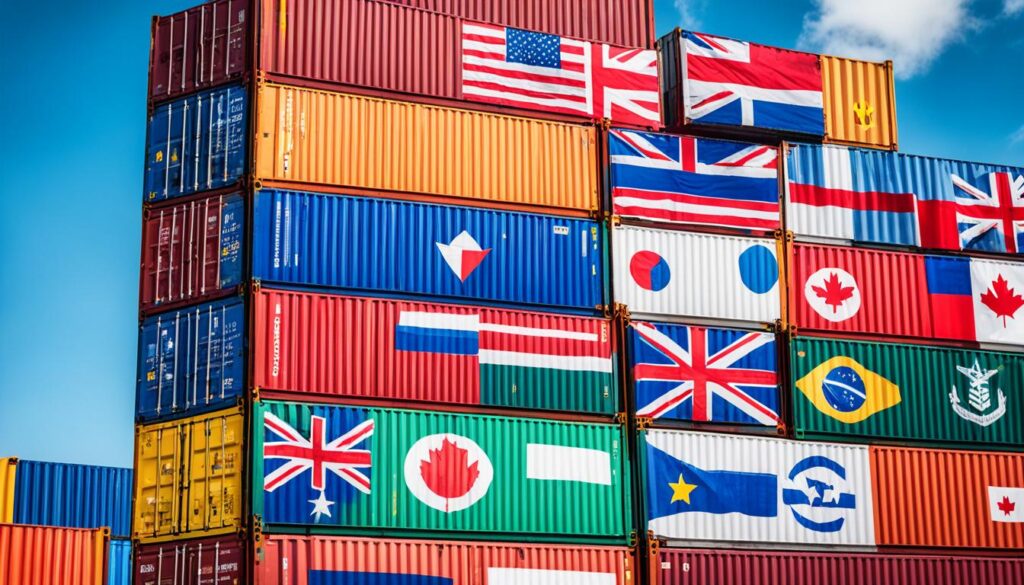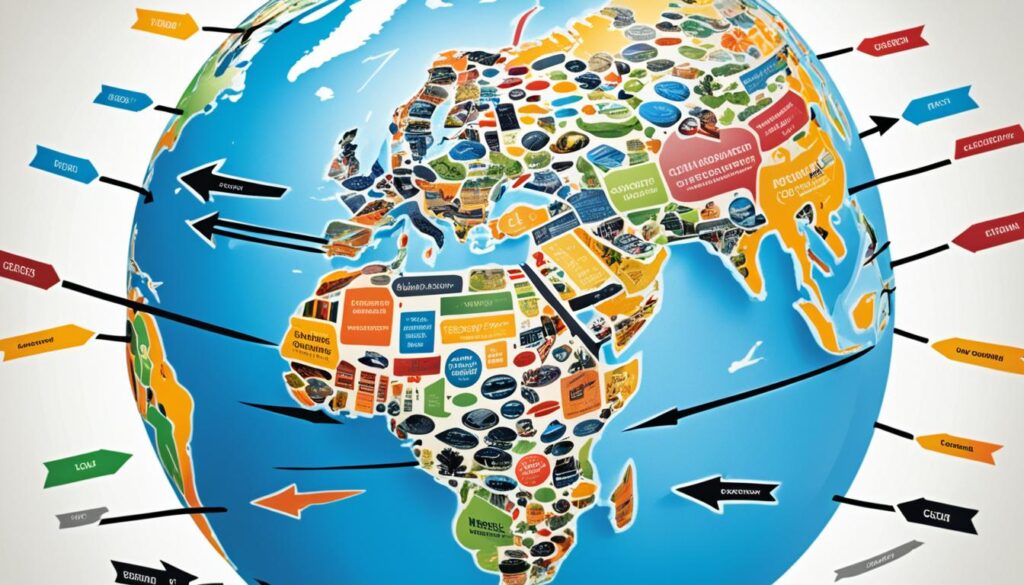In the complex world of international trade, conflicts and disputes are bound to arise. From trade imbalances and tariff disputes to disagreements over trade practices, these issues have significant economic implications. So, how can nations effectively address and resolve trade disputes? And what role does expertise play in finding a resolution?
Join me on a journey as we delve into the intricacies of trade dispute resolution. We will explore the various mechanisms used, such as bilateral negotiations, the World Trade Organization (WTO), and mediation and arbitration. Discover how diplomacy plays a crucial role in preventing conflicts from escalating and find out how historical examples and recent trade tensions shed light on the challenges and importance of effective resolution.
Key Takeaways:
- Trade disputes are inevitable in the interconnected world of international trade.
- Nations use various mechanisms, including bilateral negotiations and the WTO, to address and resolve trade disputes.
- Diplomacy plays a crucial role in preventing trade conflicts from escalating.
- Historical examples, like the Smoot-Hawley Tariff Act, and recent trade tensions provide insights into the complexities of trade dispute resolution.
- Effective resolution of trade disputes is essential for maintaining global economic stability and prosperity.
Understanding Trade Disputes
Trade disputes encompass a wide range of conflicts that have significant economic implications for businesses and consumers. These disputes can arise from various factors, such as tariff disputes, unfair trade practices, and intellectual property issues.
One common type of trade dispute is a tariff dispute, where nations impose tariffs on each other’s goods, leading to retaliatory measures. Tariffs are taxes or fees imposed on imported goods, and they can disrupt the flow of goods and services across borders.
Disputes can also arise from alleged unfair trade practices, such as dumping or subsidies. Dumping refers to selling goods in a foreign market at a price lower than their domestic market, while subsidies involve providing financial support or incentives to domestic industries, giving them an unfair advantage in international trade.
Furthermore, the protection of intellectual property rights and concerns over piracy can also contribute to trade disputes. Intellectual property includes patents, trademarks, and copyrights, and the infringement of these rights can lead to disputes between nations.
Trade disputes often have far-reaching consequences, impacting industries, supply chains, and the overall economy. Resolving these disputes requires careful negotiation and robust conflict resolution mechanisms.
The Economic Significance
Trade disputes have a profound impact on businesses, consumers, and global economic stability. Tariffs and trade restrictions can disrupt supply chains, leading to increased production costs for businesses. This disrupts their profitability and poses challenges for long-term planning. Additionally, trade conflicts can have a direct impact on consumers, resulting in higher prices for imported goods. The rising cost of goods can squeeze household budgets and reduce purchasing power, affecting overall consumer sentiment and spending habits.
Moreover, ongoing trade disputes can create uncertainty in the financial markets, leading to heightened volatility and reduced investor confidence. This uncertainty can ripple through various sectors of the economy, potentially impacting investment decisions, job creation, and overall economic growth.
Global economic stability is also at stake when trade disputes persist. The interconnectedness of economies means that disruption in one region can have spillover effects on others. A prolonged trade conflict between major economies can disrupt international trade flows, reduce business investment, and hinder economic integration. This not only impacts the countries directly involved but also has wider implications for regional and global economic stability.
“Trade disputes can pose significant risks to businesses, consumers, and the broader global economy. They can disrupt established supply chains, increase costs, and decrease investments. To mitigate these risks, it is crucial to have effective mechanisms in place for resolving trade disputes and promoting fair and open trade.”
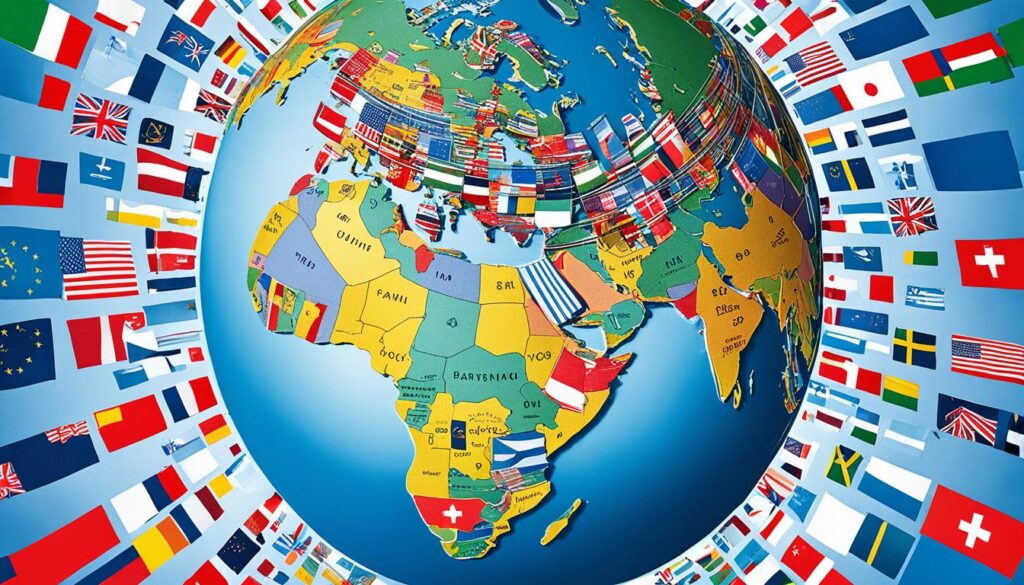
The impact on businesses
For businesses, trade disputes can have immediate and long-term consequences. Tariffs and trade restrictions can disrupt established supply chains, forcing companies to find alternative sources of inputs or relocate production facilities. This results in increased production costs, which can erode profit margins and hinder business expansion.
Furthermore, the uncertainty caused by trade disputes can deter business investments and strategic planning. Companies may delay new investments or expansion plans until there is more clarity on the future trade environment, affecting job creation and economic growth.
The consumer impact
Trade disputes also have a direct impact on consumers. As tariffs and trade barriers are imposed, the cost of imported goods may rise. This can lead to higher prices for consumer goods, reducing purchasing power and potentially affecting overall consumer demand. In addition, trade disputes can disrupt the availability of certain products, leading to supply shortages and further exacerbating price increases.
Consumers may need to adjust their spending habits and budgets as prices rise, potentially impacting their overall consumption levels and economic well-being.
“The economic impact of trade disputes on businesses and consumers underscores the importance of finding effective resolution mechanisms. By resolving disputes in a timely and fair manner, we can mitigate economic uncertainty and foster stability in the global trade landscape.”
Conflict Resolution Mechanisms
Nations employ various mechanisms to address and resolve trade disputes. These mechanisms include bilateral negotiations, the World Trade Organization (WTO), and mediation and arbitration.
- Bilateral Negotiations: Bilateral negotiations involve direct negotiations between the parties involved and can effectively resolve many trade disputes. Through mutual dialogue and compromise, nations can reach mutually acceptable solutions, promoting fair and balanced trade.
- World Trade Organization (WTO): The WTO provides a comprehensive framework for resolving trade disputes. It facilitates formal processes and mechanisms for resolving conflicts, ensuring that disputes are settled in accordance with international trade rules and regulations. The WTO’s Dispute Settlement Understanding (DSU) allows member countries to bring their grievances to the Organization for resolution through dispute settlement panels and Appellate Body reviews.
- Mediation and Arbitration: Mediation and arbitration offer alternative approaches to settling trade conflicts. These methods provide a less formal and more flexible process compared to traditional legal procedures. Through mediation, a neutral third party assists in negotiations, helping the disputing parties reach a mutually satisfactory agreement. Meanwhile, arbitration involves presenting the dispute to an impartial arbitrator or panel for a binding decision that both sides are obligated to accept. These methods can save time and costs associated with lengthy legal battles.
Role of Bilateral Negotiations
Bilateral negotiations play a crucial role in trade dispute resolution. They allow nations to engage directly and foster productive dialogue to find common ground. Through open and transparent discussions, countries can address their concerns, interests, and objectives, aiming to reach mutually beneficial outcomes.
“Bilateral negotiations offer a direct platform for efficient and tailored resolution of trade disputes, promoting constructive engagement between nations.” – Trade Expert
The benefit of bilateral negotiations lies in their flexibility and adaptability to the specific circumstances of each dispute. Parties have the freedom to explore creative solutions and consider factors beyond legal considerations, such as economic, political, and social aspects. This approach can lead to more tailored and sustainable resolutions that meet the unique needs and interests of the involved parties.
The World Trade Organization Framework
The World Trade Organization (WTO) provides a structured framework for resolving trade disputes among member countries. Its dispute settlement procedure is a key element in maintaining a predictable and rules-based international trading system.
“The WTO’s dispute settlement mechanism plays a vital role in ensuring compliance with international trade rules and fair resolution of conflicts.” – Trade Analyst
The WTO’s dispute settlement process involves the establishment of panels to review the claims and counter-claims of the parties involved. These panels examine the legal merits of the case and issue reports with recommendations. If no mutually agreeable solution is reached, the dispute can be referred to the WTO’s Appellate Body for a final decision.
This structured process provides transparency, fairness, and the enforcement of international trade rules. It promotes compliance with trade agreements and helps prevent recurring disputes in the future, fostering stability and predictability in global commerce.

Efficiency Through Mediation and Arbitration
Mediation and arbitration offer alternative paths to resolving trade disputes efficiently and effectively, minimizing the need for lengthy legal proceedings.
“Mediation and arbitration provide practical alternatives to traditional legal battles, offering a streamlined and cost-effective resolution process.” – Trade Consultant
In mediation, a neutral third party assists the disputing parties in reaching a mutually acceptable agreement. The mediator facilitates discussions, encouraging open communication and guiding negotiations. This collaborative approach allows the involved parties to explore and consider various options, with the goal of finding a mutually satisfactory outcome.
Arbitration, on the other hand, involves presenting the dispute to a neutral arbitrator or panel for a binding decision. The arbitrator, chosen by mutual agreement or through an established arbitration institution, reviews the evidence and arguments presented by both sides. The final decision is legally binding, providing certainty and closure to the dispute.
Mediation and arbitration can bypass the complexities and delays associated with traditional court proceedings. Their flexibility and adaptability allow for personalized solutions that align with the unique circumstances of each dispute, promoting swift and efficient resolution.
The Role of Diplomacy
Diplomacy plays a crucial role in resolving trade disputes. Through diplomatic negotiations, nations strive to find mutually acceptable solutions to trade conflicts, preventing escalation into full-blown trade wars. Diplomacy can help maintain productive relationships between nations while resolving conflicts effectively and peacefully.
“Diplomacy is the art of telling plain truths politely.” – Charles Curtis
Effective diplomatic negotiations require skilled diplomats adept at managing complex trade issues and understanding the interests and concerns of all parties involved. Diplomats engage in open dialogue and constructive dialogue, fostering an atmosphere of understanding and cooperation. By prioritizing communication and dialogue rather than confrontation, diplomatic negotiations can prevent trade disputes from spiraling out of control.
The Power of Diplomatic Negotiations
In trade disputes, diplomatic negotiations serve as a platform for countries to express their grievances, propose solutions, and find common ground. Negotiations provide an opportunity for nations to address their concerns, respect each other’s positions, and explore innovative approaches that benefit all involved parties.
Through diplomatic negotiations, countries can establish trade agreements, resolve tariff disputes, and harmonize trade practices. This process not only prevents further escalation but also contributes to fostering economic growth and stability at a global level.
The Art of Compromise
Diplomatic negotiations require a willingness to compromise and find middle ground. Trained diplomats understand the importance of give-and-take and seek solutions that accommodate the interests of all parties involved.
Successful diplomatic negotiations involve finding creative solutions that address the underlying concerns and interests of each nation. This balancing act helps build trust and goodwill, ensuring the durability and sustainability of trade agreements.
Diplomacy as a Catalyst for Peace
By promoting dialogue and understanding, diplomacy can serve as a catalyst for peace in the international arena. Successfully resolving trade disputes through diplomatic means highlights the power of communication and negotiation in averting larger conflicts.
Diplomatic negotiations not only address immediate trade disputes but also contribute to the overall peaceful coexistence of nations in a complex and interconnected world. Through thoughtful and diplomatic engagement, countries can prevent the escalation of trade disputes and pave the way for mutually beneficial economic relationships.
In the next section, we will delve into the historical context of trade disputes, examining past events and their implications on trade relations.

| Benefits of Diplomatic Negotiations | Effective Negotiation Strategies |
|---|---|
| 1. Prevents escalation of trade conflicts | 1. Active listening and understanding |
| 2. Promotes peaceful resolution | 2. Establishing common goals |
| 3. Fosters economic stability | 3. Building trust and rapport |
| 4. Encourages cooperation and dialogue | 4. Creative problem-solving |
Historical Context
When examining trade disputes and conflict resolution, historical examples offer valuable insights into the complexities of these issues. One such example is the Smoot-Hawley Tariff Act, enacted during the Great Depression in the 1930s. This act imposed high tariffs on imported goods, creating trade tensions and exacerbating the global economic crisis. The Smoot-Hawley Tariff Act highlighted the potential negative consequences of protectionist trade policies and the importance of considering the broader economic impact of trade disputes.
The Smoot-Hawley Tariff Act and Escalating Trade Tensions
The implementation of the Smoot-Hawley Tariff Act had far-reaching consequences. By raising tariffs on imported goods, the act aimed to protect domestic industries and stimulate the struggling American economy. However, the act had unintended consequences, leading to retaliation from other countries and worsening the global economic downturn. The increased tariffs disrupted international trade flows, contributed to a decline in global economic activity, and deepened the severity of the Great Depression.
“The Smoot-Hawley Tariff Act is a clear example of the unintended consequences that protectionist trade policies can have on a global scale. While it was implemented to protect domestic industries, it ultimately contributed to a further decline in the global economy.” – Trade Economist
In contrast to the challenges posed by the Smoot-Hawley Tariff Act, the World Trade Organization (WTO) has established a dispute settlement system that has proven successful in resolving trade disputes. The WTO’s dispute settlement mechanism provides a platform for member nations to address and settle trade conflicts, promoting stability and fostering global trade relationships.
Successful WTO Dispute Settlements
The WTO’s dispute settlement system has effectively resolved numerous trade disputes over the years. By providing a neutral and impartial forum for negotiations and adjudication, the WTO has played a significant role in facilitating trade resolution worldwide.
“The WTO’s dispute settlement system has proven to be an instrumental tool in resolving trade conflicts and maintaining order in the global trade landscape.” – Trade Analyst
The WTO’s dispute settlement process involves consultations, panels, and the Appellate Body, which collectively ensure transparency, fairness, and adherence to international trade rules. Through its dispute settlement system, the WTO has successfully resolved complex trade conflicts, enabling the continued flow of goods and services across borders.
Contemporary Trade Disputes
Recent trade conflicts have brought to the forefront the importance of effective conflict resolution mechanisms in today’s global economy. One prominent example is the ongoing trade tensions between the United States and China, which have captivated international attention. The U.S.-China trade tensions have escalated through tariff disputes and allegations of unfair trade practices, creating significant economic implications for both countries and beyond.
Amidst these tensions, intellectual property disputes have emerged as a central issue in trade conflicts. Countries are increasingly striving to protect their intellectual property rights and address concerns over piracy and infringement. Intellectual property disputes have the potential to disrupt trade relations and impact industries such as technology, pharmaceuticals, and entertainment.
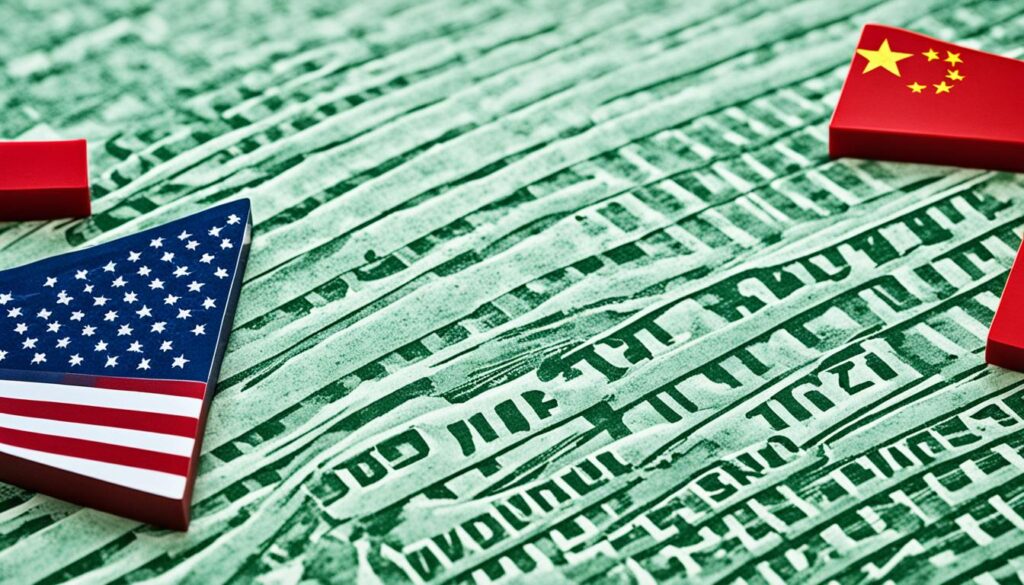
Developing effective resolution strategies to address these contemporary trade disputes is crucial for maintaining economic stability and fostering global cooperation. By engaging in meaningful dialogue and utilizing existing dispute resolution mechanisms, nations can seek mutually beneficial outcomes.
| Key Points | Implications |
|---|---|
| U.S.-China trade tensions | Impact on global supply chains and consumer prices |
| Intellectual property disputes | Risks to innovation and international trade relations |
| Need for robust resolution strategies | Strengthening economic stability and fostering cooperation |
The resolution of contemporary trade disputes requires a comprehensive understanding of the underlying issues, careful negotiation, and adherence to international trade laws. Easing tensions and finding common ground through dialogue and cooperation can lead to mutually beneficial outcomes for all parties involved.
Challenges and Risks
As with any conflict resolution process, trade disputes present their fair share of challenges and risks. These disputes often involve complex economic and legal issues, requiring careful consideration and analysis to find a satisfactory resolution. The intricacies of trade policies, market dynamics, and international regulations add to the complexity of the disputes, making it crucial to navigate the intricate web of interconnected factors.
Moreover, political factors can complicate the resolution of trade disputes, potentially prolonging the process and hindering effective resolution. Trade negotiations often become intertwined with broader geopolitical tensions and strategic considerations, further complicating the resolution process. The competing interests and varying priorities among nations can create additional hurdles on the path to finding common ground.
Resolving trade disputes requires a deep understanding of both the complex economic and legal aspects involved and the political factors that come into play. Effectively addressing these challenges is essential to ensure fair and mutually beneficial outcomes for all parties involved.
Successfully navigating the complexities and managing the political realities of trade disputes requires skilled negotiators, expertise in international trade law, and in-depth knowledge of the specific industries and markets involved. Balancing the diverse interests and finding common ground is a delicate undertaking that demands expertise, patience, and a commitment to reaching a satisfactory resolution.
Challenges and Risks in Trade Dispute Resolution
| Challenges | Risks |
|---|---|
| Complex economic and legal issues | Prolonged resolution process |
| Interconnected trade policies and market dynamics | Ineffective resolution leading to escalating tensions |
| Political considerations and competing interests | Disrupting trade relationships and agreements |
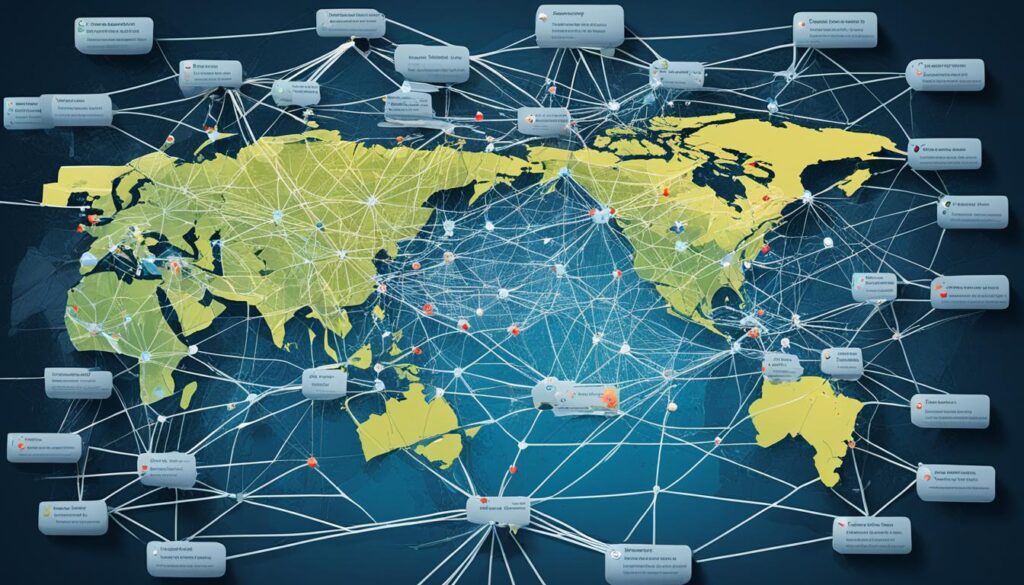
Conclusion
Trade disputes are an inherent aspect of the globalized economy, reflecting the complexities of international trade relations. These conflicts can arise from factors such as trade imbalances, tariff disputes, unfair trade practices, or intellectual property concerns. However, the manner in which nations manage and resolve these disputes has far-reaching consequences for the global economic order.
Nations employ various trade dispute resolution mechanisms to address these conflicts. Bilateral negotiations, mediated and arbitrated by international frameworks like the World Trade Organization (WTO), play a crucial role in finding mutually acceptable solutions. The trade dispute resolution process requires a delicate balance between protecting economic interests and ensuring stability in the global trade arena.
Effective trade negotiation strategies, driven by diplomacy and careful consideration of economic and legal complexities, are key to successfully resolving conflicts. As we navigate this complex landscape, it is essential to foster economic stability and prosperity on the world stage. By utilizing trade dispute resolution mechanisms and applying strategic negotiation tactics, nations can preserve the integrity of international trade while safeguarding their own economic interests.


